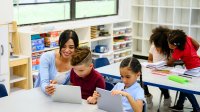3 Apps to Make Differentiation Easier in Kindergarten
Short, developmentally appropriate sessions with educational apps can help students who start in different places academically make learning gains.
Teaching kindergarten is hard.
In a kindergarten classroom, there are usually more than 20 students on the roster. These students come from different backgrounds and have different academic and social needs. Some come in knowing how to read and write; some have never seen or held a book. Some have never even been in a classroom setting before, and teachers are left to figure out how to help all of them.
On top of having to meet the needs of all students, teachers are also expected to use available technology now more than ever. One of the challenges of implementing an innovation in technology, such as blended learning, is that teachers lack training and/or awareness of how to do this in their own classrooms. Yet using blended learning could help alleviate some of the stresses that come with having a kindergarten class with so many different academic needs.
Luckily for teachers and students, many of today’s classrooms are set up to integrate technology via student computers, laptops, computer labs, iPads, Chromebooks, and other devices. Through the use of these devices, students can produce work that they would like to share with their families, and fortunately there are a lot of resources available to help bring blended learning into kindergarten classrooms.
3 Helpful Apps for Kindergarten Students
Seesaw: Educational applications such as Seesaw help students publish their work in a digital journal. That journal is not just seen by their teacher; it’s also something they can share with their families at home. Seesaw is developmentally appropriate to use in kindergarten, since it’s so easy to navigate.
The app has a plethora of activities in different subjects ready to use, so prep time for teachers is minimal. Additionally, it has personalized activities that can be assigned based on student needs. It also bridges home and school because parents are able to see things their child needs to work on. Seesaw is a tool that was used frequently to help students during distance learning, and it’s easily adaptable to in-person classes.
Epic: In kindergarten, foundational skills such as reading are taught. An application like Epic offers teachers and students access to thousands of books, videos, and quizzes all at their fingertips. This is another application that can be used at home to assist parents in helping their children read.
Epic is loved by educators because it has books in different subject areas, such as math, science, and social studies. It also offers books in Spanish. Students love it because if they are ready, they can use it to read books; if they are not ready yet, many books have a read-aloud option. In a blended-learning environment, Epic can be used in a station during small group instruction time.
Raz-Plus: Another resource that can be used when implementing blended learning is the application Raz-Plus. It also puts more books in students’ hands. Additionally, for teachers, Raz-Plus helps with the management of guided-reading books. Instead of managing more than 20 books daily, teachers can push leveled readers out to students via the Raz-Plus application. This is another tool that can be used during station time and also at home.
Blended learning does not happen overnight. Just as providing differentiation and enrichment to all students can be a hard task, blended learning takes a lot of trial and error. Adjustments need to happen along the way in order to meet all students’ needs.
In kindergarten, the station-rotation model seems to be the most practical choice, since stations are already in place during guided-reading blocks. While students at one station use Seesaw, another group of students can work collaboratively, and a third group can work with the teacher.
The last thing teachers need is more work on their plates. Adding blended learning to station time is an adjustment that can be made easily and results in helping students grow in areas of need. Utilizing tech tools as part of a station-rotation model also ensures that kindergarten students aren’t getting too much screen time during the school day.
Technology is much more widely available to our students now. As educators, we need to figure out how to use it in a way that will benefit all learners. Blended learning has helped educators like myself find a good balance when trying to enrich and differentiate instruction for our school’s youngest students.
